英语中形容词和副词变化规则
形容词和副词的转换

形容词和副词的转换形容词和副词是英语语法中非常重要的词类,它们有着相互转换的关系。
形容词通常用于修饰名词或代词,而副词则用于修饰动词、形容词或其他副词。
在表达中,我们经常需要从形容词转换为副词或从副词转换为形容词。
本文将探讨形容词和副词之间的转换规则和应用技巧。
1. 形容词转副词形容词转换为副词的一般规则是在形容词末尾加上"-ly"。
下面是一些常见的例子:- quick(形容词)→ quickly(副词)- happy(形容词)→ happily(副词)- easy(形容词)→ easily(副词)2. 副词转形容词副词转换为形容词的一般规则是去掉副词末尾的"-ly",并在词尾加上"-y"。
以下是一些例子:- quickly(副词)→ quick(形容词)- happily(副词)→ happy(形容词)- easily(副词)→ easy(形容词)需要注意的是,并非所有副词都能直接转换为形容词。
有一些副词在转换时需要使用特殊规则或添加其他后缀。
下面是几个例子:- good(形容词)→ well(副词),但"well"无法再转换为形容词。
- bad(形容词)→ ba dly(副词),但"badly"无法再转换为形容词。
- true(形容词)→ truly(副词),但"truly"无法再转换为形容词。
3. 词性转换的应用形容词和副词的转换不仅仅是一种语法规则,更是我们表达中丰富词汇和语义的重要方式。
正确灵活地运用形容词和副词的转换,可以使我们的表达更加准确、生动、有力。
- 形容词用于修饰名词或代词,可以让描述更具体、形象。
例如:"She is a beautiful girl."(她是个漂亮的女孩。
)- 副词用于修饰动词或形容词,可以使描述更具说服力和情感色彩。
高三英语二轮复习形容词副词转换规则以及举例知识清单
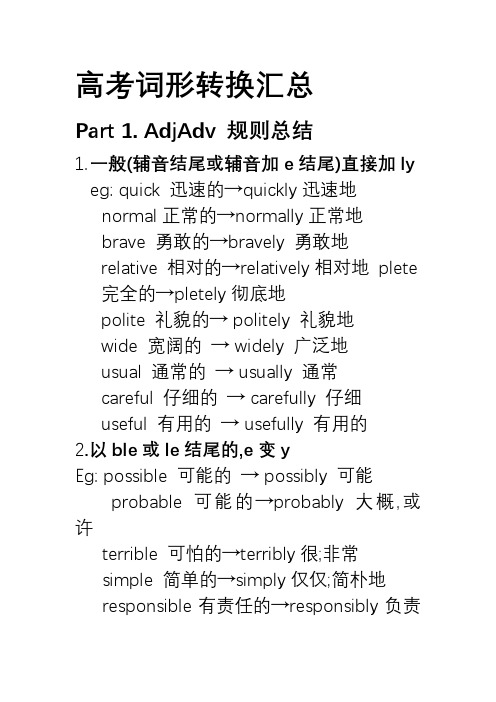
高考词形转换汇总Part 1. AdjAdv 规则总结1.一般(辅音结尾或辅音加e结尾)直接加ly eg: quick 迅速的→quickly迅速地normal正常的→normally正常地brave 勇敢的→bravely 勇敢地relative 相对的→relatively相对地 plete 完全的→pletely彻底地polite 礼貌的→ politely 礼貌地wide 宽阔的 → widely 广泛地usual 通常的 → usually 通常careful 仔细的 → carefully 仔细useful 有用的 → usefully 有用的2.以ble或le结尾的,e变yEg: possible 可能的 → possibly 可能probable 可能的→probably 大概,或许terrible 可怕的→terribly很;非常simple 简单的→simply仅仅;简朴地responsible有责任的→responsibly负责地注意: whole 完整的→wholly完全地3.以元音字母加e结尾的,去e加lyEg: true 真正的→truly真正地4.辅音加y结尾的,y变i加lyEg: happy 高兴的→happily 高兴地angry 生气的,愤怒的→angrily生气地,愤怒地heavy 沉重的,繁重的→heavily严重地;沉重地lucky 幸运的,运气的 → luckily 幸运地heavy 沉重的 → heavily 沉重地noisy 喧闹的 → noisily 喧闹地注意:结尾的y如果发音是/aI/,直接加ly shy 害羞的→shyly 害羞地5.词尾为ll,直接加yEg: full 满的,充满的→fully完全地,全部地 dull 单调的;乏味的→dully木然地6.以ic结尾的,先加al,再加lyEg: economic经济的→economically经济地basic 基础的,基本的→basically大体上,基本上scientific 科学的→scientifically合乎科学地automatic自动的→automatically自动地energetic精力充沛的→energetically精力充沛地注意:public公开的→publicly公开地Part 2. AdjAdv 高频单词总结1.original 原来的→originally 原来2. eventual 最后的→eventually最后3. accidental 偶然的→accidentally偶然地4. rough 粗略的→roughly大约5. undoubted 无疑的→undoubtedly毋庸置疑地6.sharp 急剧的→sharply急剧地7. extreme 极度的→extremely极端地;极度地8. certain 确定的→certainly 当然9.gentle 平缓的→gently平缓地10. particular 特别的→particularly 尤其11. poor 不佳的→poorly 糟糕地12.final 最终的→finally终于,最终13.huge巨大的→hugely极其14. easy 容易的→easily 容易地15. actual 真实的→actually事实上16. recent 近来的→recently近来17.fair 相当的→fairly相当地18. real 真正的→really真实地19. official 正式的→officially正式地20. possible 可能的 possibly可能地21. slow 缓慢的 → slowly 缓慢地22. loud 大声地 → loudly 大声地23. sudden 突然的 → suddenly 突然24.quick 迅速的→quickly迅速地25.normal正常的→normally正常地26.brave 勇敢的→bravely 勇敢地27.relative 相对的→relatively相对地28.plete完全的→pletely彻底地29.probable 可能的→probably 大概,或许30.terrible 可怕的→terribly很;非常31.simple 简单的→simply仅仅;简朴地32.responsible有责任的→responsibly负责地33.whole 完整的→wholly完全地34.true 真正的→truly真正地35.happy 高兴的→happily 高兴地36.angry 生气的,愤怒的→angrily生气地,愤怒地37.heavy 沉重的,繁重的→heavily严重地;沉重地38.lucky 幸运的,运气的 → luckily 幸运地39.heavy 沉重的 → heavily 沉重地40.noisy 喧闹的 → noisily 喧闹地41.shy害羞的→shyly 害羞地42.polite 礼貌的→ politely 礼貌地43.wide 宽阔的 → widely 广泛地ual 通常的 → usually 通常45.careful 仔细的 → carefully 仔细eful 有用的 → usefully 有用的47.full 满的,充满的→fully完全地,全部地48.dull 单调的;乏味的→dully木然地49.economic经济的→economically经济地50.basic 基础的,基本的→basically大体上,基本上51.scientific 科学的→scientifically合乎科学地52.automatic自动的→automatically自动地53.energetic精力充沛的→energetically精力充沛地54.public公开的publicly公开地。
形容词变副词的变化规则(名词修改):形容词与副词的区别
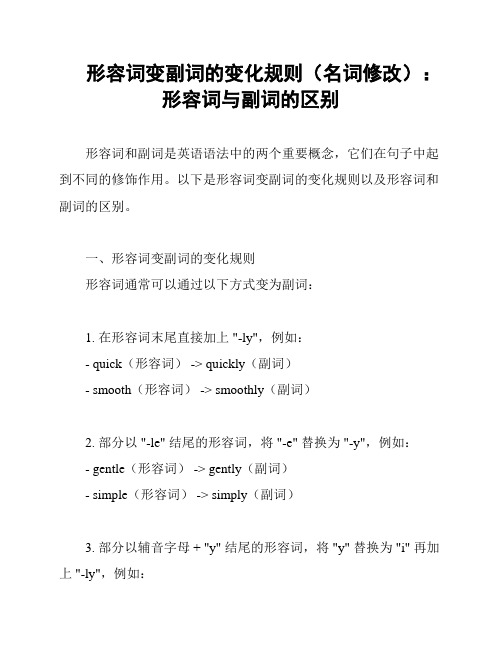
形容词变副词的变化规则(名词修改):形容词与副词的区别形容词和副词是英语语法中的两个重要概念,它们在句子中起到不同的修饰作用。
以下是形容词变副词的变化规则以及形容词和副词的区别。
一、形容词变副词的变化规则形容词通常可以通过以下方式变为副词:1. 在形容词末尾直接加上 "-ly",例如:- quick(形容词) -> quickly(副词)- smooth(形容词) -> smoothly(副词)2. 部分以 "-le" 结尾的形容词,将 "-e" 替换为 "-y",例如:- gentle(形容词) -> gently(副词)- simple(形容词) -> simply(副词)3. 部分以辅音字母 + "y" 结尾的形容词,将 "y" 替换为 "i" 再加上 "-ly",例如:- happy(形容词) -> happily(副词)- busy(形容词) -> busily(副词)4. 部分以"-ic" 结尾的形容词,将"-ic" 替换为"-ically",例如:- economic(形容词) -> economically(副词)- automatic(形容词) -> automatically(副词)5. 部分形容词本身是副词,无需变化,例如:- fast(快速的)-> fast(快速地)- well(好的)-> well(好地)需要注意的是,并非所有形容词都可以直接变为副词,有些形容词在用作副词时形式与原形相同,例如:- hard(难的、努力地)- late(晚的、晚地)- high(高的、高地)二、形容词和副词的区别形容词和副词在修饰对象和作用方式上有着不同:1. 形容词(Adjective)通常用来修饰名词或代词,描述它们的特征或性质。
副词变形容词变化规则
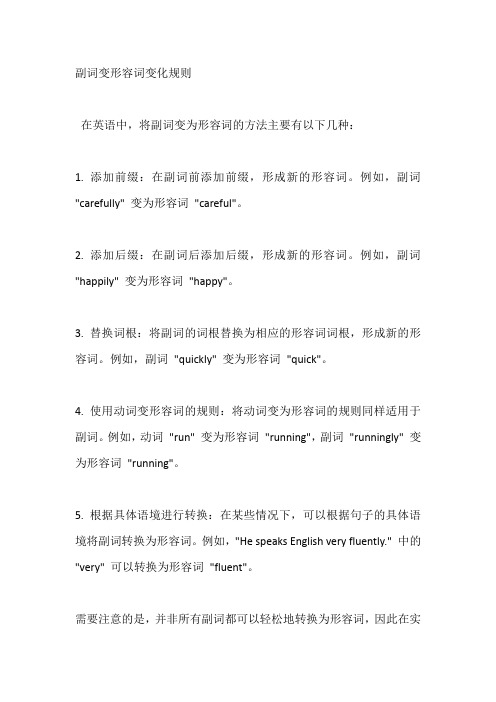
副词变形容词变化规则
在英语中,将副词变为形容词的方法主要有以下几种:
1. 添加前缀:在副词前添加前缀,形成新的形容词。
例如,副词"carefully" 变为形容词"careful"。
2. 添加后缀:在副词后添加后缀,形成新的形容词。
例如,副词"happily" 变为形容词"happy"。
3. 替换词根:将副词的词根替换为相应的形容词词根,形成新的形容词。
例如,副词"quickly" 变为形容词"quick"。
4. 使用动词变形容词的规则:将动词变为形容词的规则同样适用于副词。
例如,动词"run" 变为形容词"running",副词"runningly" 变为形容词"running"。
5. 根据具体语境进行转换:在某些情况下,可以根据句子的具体语境将副词转换为形容词。
例如,"He speaks English very fluently." 中的"very" 可以转换为形容词"fluent"。
需要注意的是,并非所有副词都可以轻松地转换为形容词,因此在实
际操作中要根据副词的词义和语境来判断是否适合转换。
形容词和副词比较级变化规则
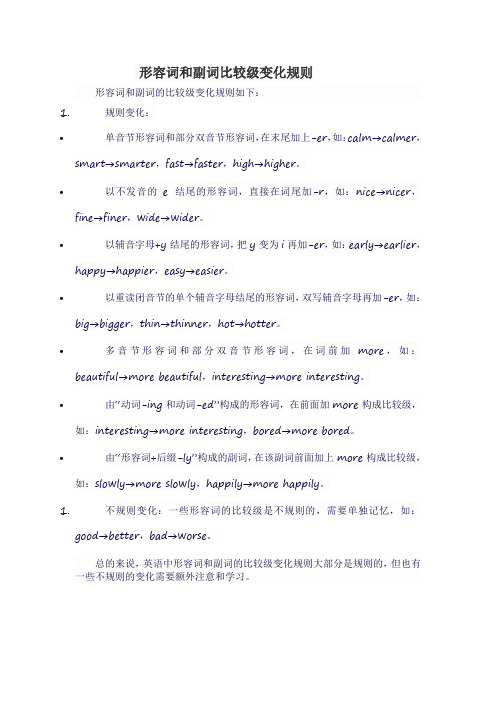
形容词和副词比较级变化规则
形容词和副词的比较级变化规则如下:
1.规则变化:
•单音节形容词和部分双音节形容词,在末尾加上-er,如:calm→calmer,smart→smarter,fast→faster,high→higher。
•以不发音的e结尾的形容词,直接在词尾加-r,如:nice→nicer,fine→finer,wide→wider。
•以辅音字母+y结尾的形容词,把y变为i再加-er,如:early→earlier,happy→happier,easy→easier。
•以重读闭音节的单个辅音字母结尾的形容词,双写辅音字母再加-er,如:big→bigger,thin→thinner,hot→hotter。
•多音节形容词和部分双音节形容词,在词前加more,如:beautiful→more beautiful,interesting→more interesting。
•由“动词-ing和动词-ed”构成的形容词,在前面加more构成比较级,如:interesting→more interesting,bored→more bored。
•由“形容词+后缀-ly”构成的副词,在该副词前面加上more构成比较级,如:slowly→more slowly,happily→more happily。
1.不规则变化:一些形容词的比较级是不规则的,需要单独记忆,如:good→better,bad→worse。
总的来说,英语中形容词和副词的比较级变化规则大部分是规则的,但也有一些不规则的变化需要额外注意和学习。
形容词副词的比较级和最高级变化规则
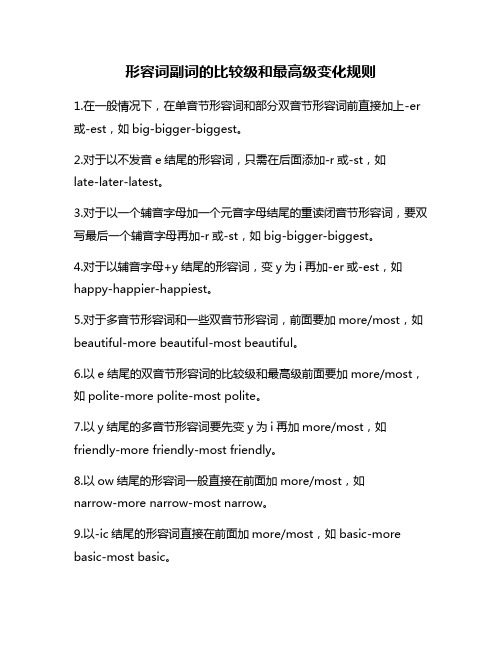
形容词副词的比较级和最高级变化规则1.在一般情况下,在单音节形容词和部分双音节形容词前直接加上-er 或-est,如big-bigger-biggest。
2.对于以不发音e结尾的形容词,只需在后面添加-r或-st,如late-later-latest。
3.对于以一个辅音字母加一个元音字母结尾的重读闭音节形容词,要双写最后一个辅音字母再加-r或-st,如big-bigger-biggest。
4.对于以辅音字母+y结尾的形容词,变y为i再加-er或-est,如happy-happier-happiest。
5.对于多音节形容词和一些双音节形容词,前面要加more/most,如beautiful-more beautiful-most beautiful。
6.以e结尾的双音节形容词的比较级和最高级前面要加more/most,如polite-more polite-most polite。
7.以y结尾的多音节形容词要先变y为i再加more/most,如friendly-more friendly-most friendly。
8.以ow结尾的形容词一般直接在前面加more/most,如narrow-more narrow-most narrow。
9.以-ic结尾的形容词直接在前面加more/most,如basic-more basic-most basic。
10.以-ive结尾的形容词直接在前面加more/most,如active-more active-most active。
11.以-able结尾的形容词直接在前面加more/most,如comfortable-more comfortable-most comfortable。
12.以-ful结尾的形容词直接在前面加more/most,如beautiful-more beautiful-most beautiful。
13.以-al结尾的形容词直接在前面加more/most,如usual-more usual-most usual。
英语形容词变副词规则(名词改为动词)
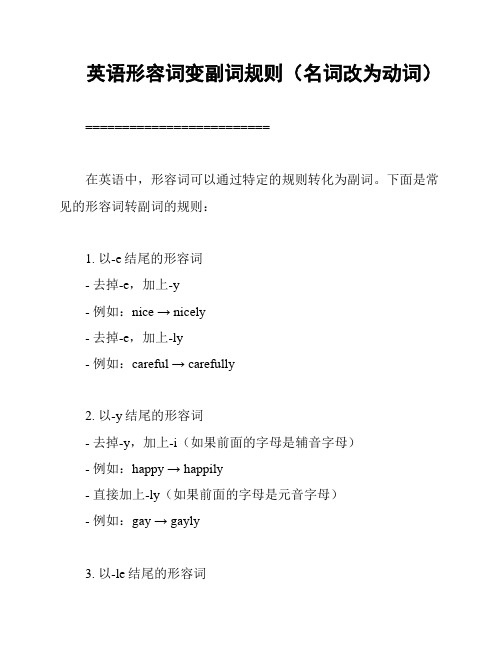
英语形容词变副词规则(名词改为动词)
=========================
在英语中,形容词可以通过特定的规则转化为副词。
下面是常见的形容词转副词的规则:
1. 以-e结尾的形容词
- 去掉-e,加上-y
- 例如:nice → nicely
- 去掉-e,加上-ly
- 例如:careful → carefully
2. 以-y结尾的形容词
- 去掉-y,加上-i(如果前面的字母是辅音字母)
- 例如:happy → happily
- 直接加上-ly(如果前面的字母是元音字母)
- 例如:gay → gayly
3. 以-le结尾的形容词
- 将-le变为-ly
- 例如:simple → simply
4. 以-r或-le结尾的形容词
- 直接加上-ly
- 例如:quick → quickly
- 例如:terrible → terribly
5. 特殊形容词
- 形容词与副词形式相同
- 例如:fast → fast
注意事项:
- 并非所有形容词都有规则的转化方式,需要根据具体情况进行研究和记忆。
- 有些形容词的副词形式与形容词形式不同,需要单独记忆。
以上是英语形容词变副词的常见规则。
通过掌握这些规则,可以帮助我们正确使用形容词和副词,并更好地表达自己的意思。
该文档共计超过800字。
英语形容词副词变化
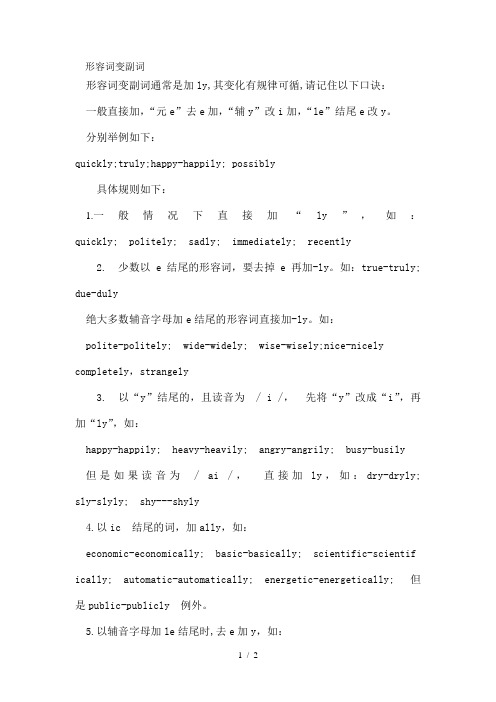
形容词变副词形容词变副词通常是加ly,其变化有规律可循,请记住以下口诀:一般直接加,“元e”去e加,“辅y”改i加,“le”结尾e改y。
分别举例如下:quickly;truly;happy-happily; possibly具体规则如下:1.一般情况下直接加“ly”,如:quickly; politely; sadly; immediately; recently2. 少数以e结尾的形容词,要去掉e再加-ly。
如:true-truly; due-duly绝大多数辅音字母加e结尾的形容词直接加-ly。
如:polite-politely; wide-widely; wise-wisely;nice-nicely completely,strangely3. 以“y”结尾的,且读音为/ i /,先将“y”改成“i”,再加“ly”,如:happy-happily; heavy-heavily; angry-angrily; busy-busily但是如果读音为/ ai /,直接加ly,如:dry-dryly; sly-slyly; shy---shyly4.以ic 结尾的词,加ally,如:economic-economically; basic-basically; scientific-scientif ically; automatic-automatically; energetic-energetically; 但是public-publicly 例外。
5.以辅音字母加le结尾时,去e加y,如:simple-simply; considerable-considerably; terrible-terribly gentle-gently; possible-possibly; probable-probably; incredible-incredibly元音字母加le时加ly,如:sole-solely。
- 1、下载文档前请自行甄别文档内容的完整性,平台不提供额外的编辑、内容补充、找答案等附加服务。
- 2、"仅部分预览"的文档,不可在线预览部分如存在完整性等问题,可反馈申请退款(可完整预览的文档不适用该条件!)。
- 3、如文档侵犯您的权益,请联系客服反馈,我们会尽快为您处理(人工客服工作时间:9:00-18:30)。
英语中形容词和副词表示“比较”和“最”这样的概念时,采用比较级和最高级形式表示。
表示两者之间的比较用比较级,表示三或者三者以上的比较用最高级。
一.对于单音节词和部分双音节词比较级和最高级的变法,1.一般情况直接加-er,或-est.
2.以e结尾的加-r或-st.
3. 以辅音字母加y结尾的,变y 为i再加-er 或.以辅元辅结尾的重读闭音节结尾的,双写末尾字母在加-er或-est.
二.大多数双音节词和多音节词,在其前加more或most.
三.不规则词:
good-better-best,well-better-best,little-less-least,much-more-most,many-more-most,bad-worse -worst,badly-worse-worst,ill-worse-worst,far-farther更远-farthest, far-further(更深)-furthest,old-elder-eldest
四.特殊情况:
1.单音节词按多音节词变化:tired-more tired-most tired, glad-more glad-most glad, right-more right-most right, pleased-more pleased-most pleased, real-more real-most real
2.既可以按单音节词也可以按多音节词变化:clever-cleverer-cleverest, clever-more clever-most clever, cold-colder-coldest, cold-more cold-most cold, friendly-friendlier-friendliest, friendly-more friendly-most friendly, often-oftener-oftenest, often-more often-most often
3.双音节词按单音节变化:
pretty-prettier-prettiest,ugly-uglier-ugliest,hungry-hungrier-hungriest,lonely-lonelier-lon eliest,healthy-healthier-healthiest,early-earlier-earliest,easy-easier-easiest,heavy-heavie r-heaviest,dirty-dirtier-dirtiest,curly-curlier-curliest,lazy-lazier-laziest,
cloudy-cloudier-cloudiest, sleepy-sleepier-sleepiest.
4.双音节按多音节变化:crucial-more crucial-most crucial, special-more special-most special, anxious-more anxious-most anxious, slowly-more slowly-most slowly, quietly-more quietly-most quietly, careful-more careful-most careful, helpful-more helpful-most helpful, pleasant-more pleasant-most pleasant, exciting-more exciting-most exciting.
比较级的运用:1.句中用到than. 2.句中明显提到两个对象,
3.同一个人在不同的时刻或者地点进行比较。
and more:比较级+and +比较级。
4.句中用到much, far, even,a little, a lot等后边的形容词或副词要用比较级形式.
5. The harder you study, the more knowledge you can learn. :the+比较级,the +比较级
=like …better更喜欢,Prefer to+动词原形: 宁愿,更喜欢
prefer…to…=like… better than…:喜欢…胜过
Prefer to+动词原形rather than动词原形:宁愿做某事,而不愿意做某事=would rather…than…
...as 之间跟形容词或副词的原级,not so/as …as
最高级的运用:1.三者或者三者以上的比较,形容词最高级前要加定冠词the,副词最高级前可以不加the, 但是前边有形容词性物主代词,所有格形式修饰时则不用The 2. 句中用到短语of all时,句中用到形容词和副词也考虑用最高级形式,
3. one of +the +形容词最高级形式+复数名词(ones)
这类似词语本身就是表示最的词语,无需再用最高级。
